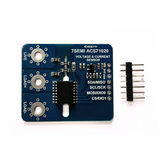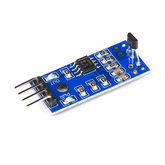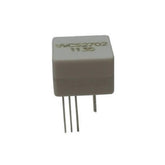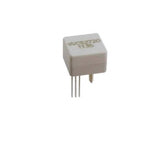What Is a Hall Effect Transducer and How Does It Work?
Summary
If you're into electronics or automation, there's a good chance you've heard someone throw around the term "Hall Effect Transducer" in a meeting or technical discussion. And if you're being honest, you probably nodded along without fully getting what it actually does.
Here's the truth: this thing is incredibly useful, and once you understand it, you'll start seeing it everywhere—your car, your phone, your home automation setup.
The cool part? It solves a problem that engineers have dealt with for decades: how do you measure magnetic fields or currents without physically touching the circuit? That's exactly what the Hall Effect Transducer does. Let's break it down in a way that actually makes sense.

Definition of Hall Effect Transducer
So, what the heck is a Hall Effect Transducer anyway? Think of it as a translator between the magnetic world and the electrical world. You've got a magnetic field (invisible, can't touch it), and you want to know how strong it is or what it's doing.
A Hall Effect Transducer takes that magnetic field and converts it into an electrical signal—specifically, a voltage—that your instruments can actually measure and work with.
Here's a brief history. Back in 1879, a scientist named Edwin Hall stumbled onto something interesting. When you push current through a conductor and throw a magnetic field at it from the side, something weird happens.
A voltage shows up. Not from the main current, but from the sides of the conductor. Nowadays, engineers call this the Hall effect, and it's one of those physics discoveries that turned out to have massive practical applications.
The reason this technology is so valuable is that it doesn't require any physical connection to what you're measuring. You can stick a Hall Effect Transducer near a current-carrying wire without cutting into it or adding resistance to the circuit. That's huge for system reliability. You measure without disturbing. Pretty elegant when you think about it.
Construction of Hall Effect Transducer
If we look inside a Hall Effect Transducer, here’s what we will find:

- The semiconductor chip – This is the real star. Usually made from silicon, gallium arsenide, or indium arsenide. These materials are special because they're doped (that's chemist-speak for deliberately contaminated with specific impurities) to make them extra sensitive to the Hall effect. Think of it like tuning an instrument to be extra responsive.
- Four connections or terminals – Two of these push current across the width of the semiconductor. The other two sit on the sides waiting to catch the voltage that develops. It's like having two pipes pushing water through, and two little sensors waiting to measure the pressure difference that builds up.
- That thin, flat shape – This isn't accidental design. The rectangular profile with relatively flat surfaces maximizes the voltage generation when a magnetic field hits it from the side. Thicker semiconductors don't work as well; thin is actually better here.
- The protective case – Real-world electronics need protection. The semiconductor gets housed in a protective package, usually ceramic or plastic, that shields it from physical damage, moisture, and temperature swings. But (and this is important) the packaging allows magnetic fields to pass through unimpeded.
- Extra circuitry inside – Modern Hall Effect Transducers aren't just bare semiconductors anymore. They've got built-in amplifiers to strengthen the signal, temperature sensors to compensate for heat-related errors, and sometimes calibration adjustments. All this electronics is crammed right into the package.
The construction quality here directly affects how accurately the Hall Effect Transducer performs. Premium versions include temperature compensation because, let's face it, the Hall voltage changes with temperature.
Get the semiconductor material right, the thickness right, and the amplification circuitry right, and you've got a reliable sensor. Cheap it out on any of those, and your measurements will drift and become unreliable.
Working Principle of Hall Effect Transducer
Alright, here's where the actual magic happens. Understanding this will make everything click into place.

Picture this: electrons are flowing through the semiconductor strip. That's your applied current. Normally, these electrons just cruise in a straight line from point A to point B. But then you introduce a magnetic field perpendicular to that flow—at a right angle.
What happens next is physics doing its thing. That magnetic field exerts a force (scientists call it the Lorentz force) on the moving electrons, and it literally pushes them toward one edge of the conductor.
Meanwhile, the positive charges (or "holes" as physicists call them) get shoved toward the opposite edge. Neither wants to be where they are, but they keep getting pushed there.
As more and more charge accumulates on each side, an electric field develops. This field points from positive to negative, like it always does. Here's the critical moment: eventually, the electric field becomes strong enough that it perfectly counterbalances the magnetic force.
Equilibrium is reached. At that point, the electrons stop getting pushed further, and you've got a stable voltage difference between the two sides of the conductor. This is the hall effect EMF that everybody talks about.
What's genuinely elegant about this process is that it's proportional. The voltage you measure depends on:
- How strong the magnetic field is – Stronger fields generate bigger voltages. Simple as that.
- How much current you're pushing through – More current amplifies the effect. Double the current, roughly double the voltage.
- What the semiconductor is made of – Different materials have different sensitivities. It's related to how many free electrons the material has and how easily they move (what physicists call "mobility").
So here's what makes it useful: once you've calibrated a specific Hall Effect Transducer for your setup, you can use that relationship backwards. Measure the voltage, plug it into your calibration numbers, and boom—you know exactly how strong the magnetic field is, or you can infer what current is flowing.
The thickness of the semiconductor matters too. Thinner materials give you bigger voltages for the same conditions, which means better sensitivity and accuracy.
Types of Hall Effect Transducer
The Hall Effect Transducer world isn't one-size-fits-all. Different situations need different approaches. Here's what's out there:
Analog Hall Effect Transducers
These output a continuous voltage that changes smoothly as the magnetic field changes. If the field gets stronger, the voltage climbs. If it gets weaker, the voltage drops. Perfect for situations where you need precise, real-time readings. Industrial motor controllers love these because they can continuously monitor current draw.
Digital Hall Effect Transducers
These are the on-off guys. You set a threshold, and once the magnetic field reaches it, the output flips from low to high (or vice versa). Great for proximity detection, speed sensing, or simple presence/absence applications. You don't need to know the exact value; you just need to know "is it there or not?"
Ratiometric Hall Effect Transducers
Here's where it gets clever. These output voltage proportional to both the magnetic field AND the supply voltage ratio. Why does this matter? Because if your power supply wobbles a bit, the output wobbles proportionally. This self-correcting feature reduces errors from unstable power supplies, which is why they're popular in automotive systems where power supply quality varies.
Open-Loop Hall Effect Transducers
This is the straightforward, direct approach. The hall effect sensor measures the magnetic field without any feedback correction. What you measure is what you get. They're cheap, they're simple, and they work fine for applications where extreme accuracy isn't critical.
Closed-Loop Hall Effect Transducers
These are the premium option. They include feedback mechanisms that automatically correct for nonlinearity and temperature drift. Costs more, but delivers accuracy that open-loop systems simply can't match. Industries like renewable energy and advanced power management systems demand closed-loop performance.
Miniature vs. Industrial-Grade Units
Space-constrained applications—your phone, smartwatch, compact electronics—use miniature Hall Effect Transducers. Industrial installations with harsh environments and demanding conditions need ruggedized units built to survive temperature extremes, vibration, and electrical noise.
Applications of Hall Effect Transducers
Okay, so where do people actually use this stuff? Everywhere. And I mean that literally.
Cars
Electric vehicles can't function without them. The battery management system constantly monitors charging and discharging currents using Hall Effect Transducers. Anti-lock braking systems? Those use Hall elements to detect wheel speed. Torque monitoring in power steering? Hall elements again. Modern engine control units use them for precise ignition timing. It's honestly hard to find a modern vehicle system that doesn't rely on them somewhere.
Manufacturing and Industrial Automation
If you've got a factory with conveyor belts, robotic arms, or precision machinery, Hall elements are probably monitoring it. Conveyor speed detection, motor load sensing, equipment positioning for precision work—they handle all of it. Robots in particular depend heavily on Hall Effect Transducers for joint angle measurement and force feedback. It's how the system "knows" what's happening.
Your Personal Electronics
Your smartphone has Hall sensors. Seriously. They detect when you're holding the phone near your ear during a call and switch the display off to save battery. Smartwatches use them for step counting and motion detection. Gaming controllers incorporate them for gesture recognition and precise controller position sensing. Wireless chargers use Hall elements to optimize charging efficiency based on device placement.
Power Systems and Grid Management
Electric utility companies use Hall Effect Transducers for grid current monitoring and load balancing. Solar installations monitor power flow from panels. Wind turbines measure generated current. UPS systems (those backup power boxes) depend on accurate Hall element readings to know when to switch from grid to battery power.
Healthcare Equipment
MRI machines require absurdly accurate magnetic field measurements—Hall elements handle this. Patient monitors use Hall sensors for non-invasive physiological measurements. Surgical instruments increasingly incorporate Hall elements for position tracking during complex procedures.
Security and Access Control
Motion-activated lighting uses Hall sensors to detect approaching people or objects. Door locks verify proper door position through Hall element sensing. Intrusion detection systems use Hall elements for window and door sensors. These contactless, reliable sensors make perfect sense for security applications.
Difference Between Hall Effect Sensor and Hall Effect Transducer
Here's something that confuses people constantly: aren't these the same thing? Not quite.
A hall effect sensor refers specifically to the semiconductor element itself. It's the raw component—the semiconductor chip with its four connections. Like talking about "the engine" in a car. It's real, it's essential, but it's not complete by itself.
A Hall Effect Transducer, by contrast, is the whole package. You get the semiconductor (the hall effect sensor) plus the supporting circuitry—amplifiers, signal conditioning, maybe temperature compensation, output formatting.
It's application-ready. You hook it up, and it works. Similar to how a complete engine comes installed in a car with all its systems integrated.
When you buy just a Hall sensor, you're getting mostly the semiconductor. You'll need to add your own electronics if you want usable output. Buy a Hall Effect Transducer, and you've got something you can integrate directly into your system.
The integration level differs too. Modern Hall Effect Transducers include temperature compensation circuits because the Hall effect changes with temperature. They include gain adjustments so you can tweak sensitivity.
Some include offset correction. All of this makes them more reliable across different environmental conditions but pushes the price higher than a basic Hall sensor.
Conclusion
The Hall Effect Transducer is one of those technologies that connects elegant physics principles to practical engineering solutions. It starts with a discovery from 1879, gets distilled into a simple semiconductor device, and ends up solving real measurement problems across dozens of industries.
From electric vehicles measuring battery current to security systems detecting motion, the Hall Effect Transducer quietly enables modern technology. As systems get smarter and more interconnected, demand for accurate, non-contact measurement keeps growing. This technology will only become more prevalent in the next decade.















